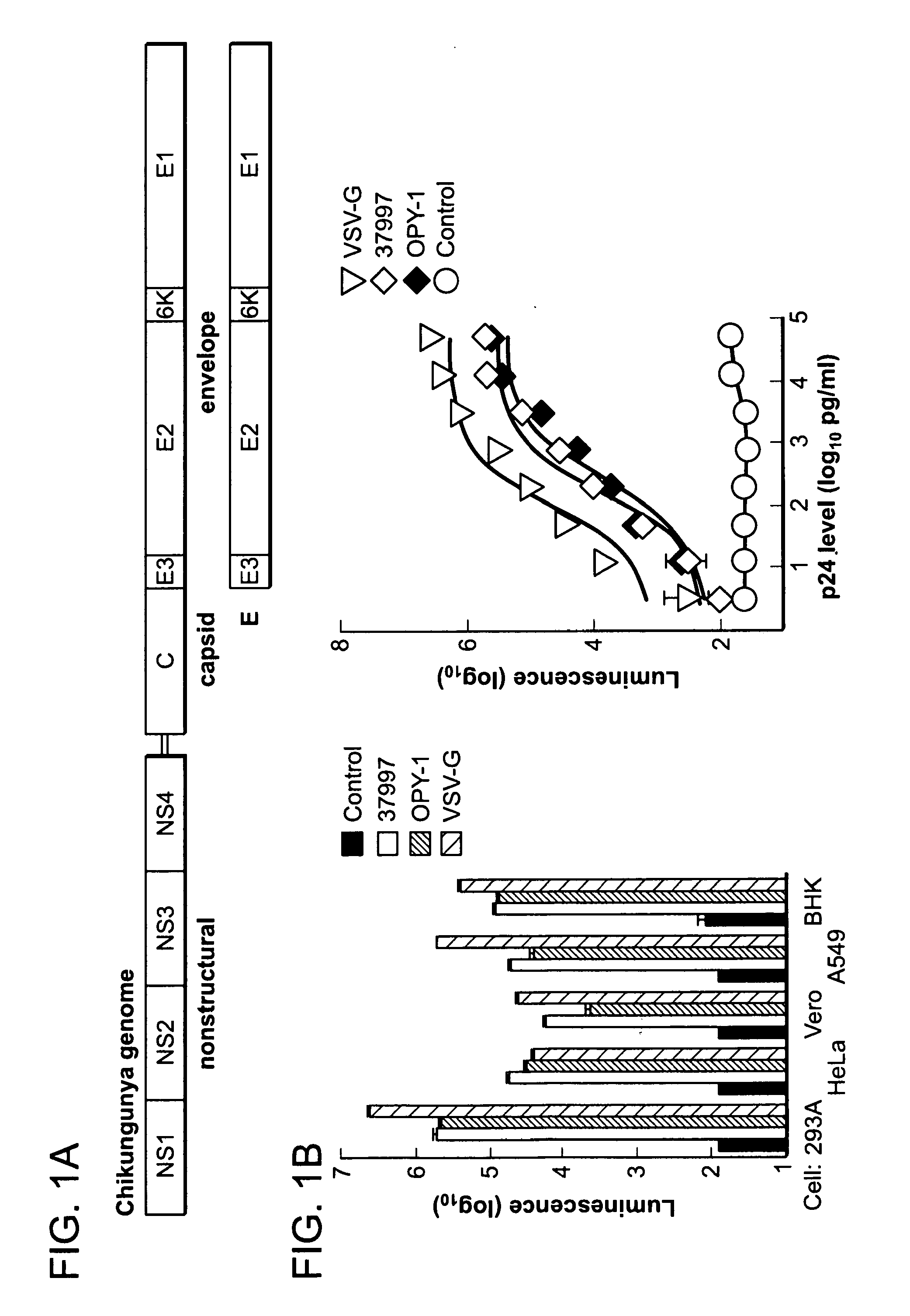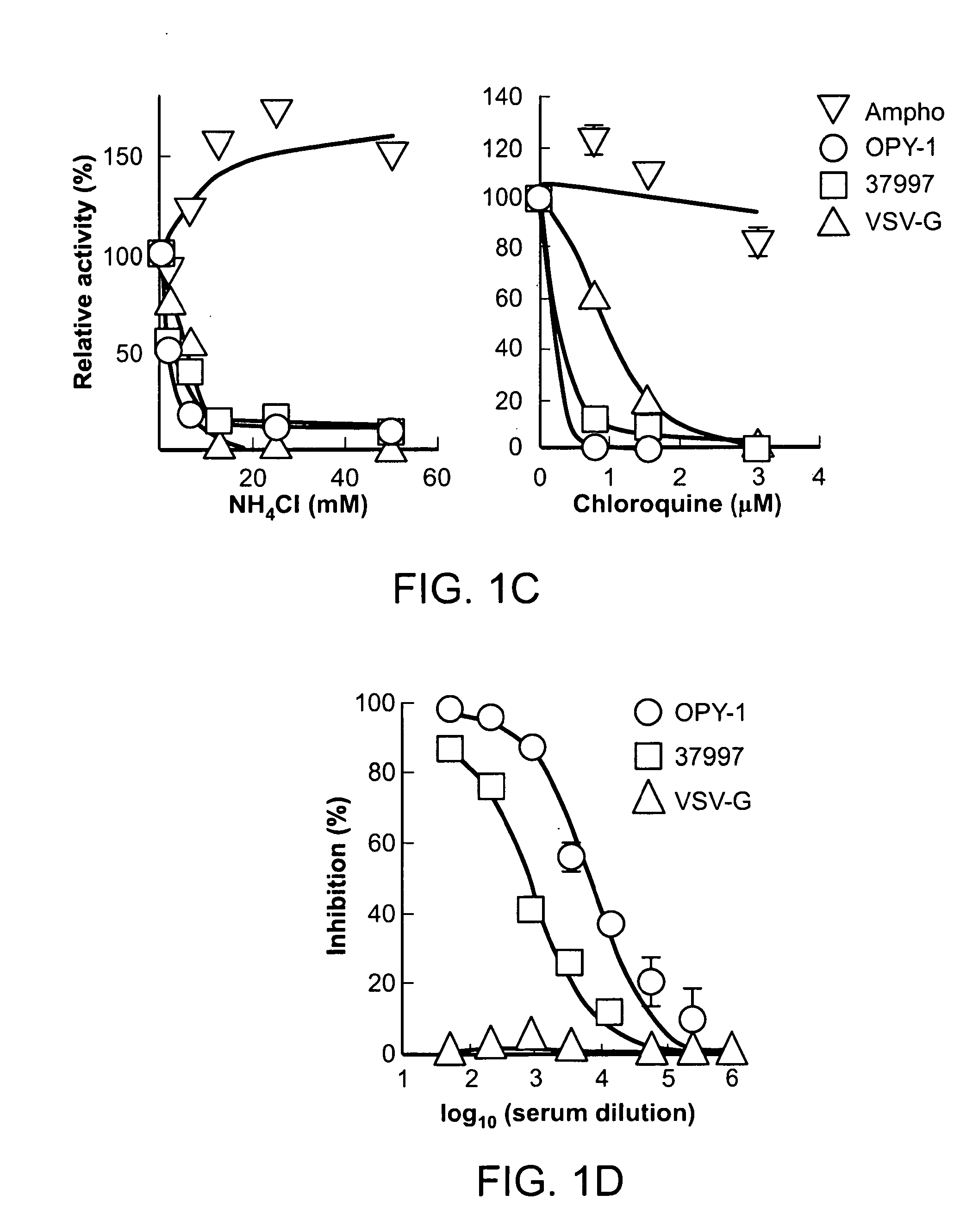Virus like particle compositions and methods of use
a technology of particle compositions and viruses, applied in the field of virus like particle compositions and methods of use, can solve the problems of serious public health impact of disease severity, and achieve the effect of easy purification
- Summary
- Abstract
- Description
- Claims
- Application Information
AI Technical Summary
Benefits of technology
Problems solved by technology
Method used
Image
Examples
example 1
Lentiviral Vectors Pseudotyped with CHIKV Envelope Mediated Entry through the Same Mechanism as Wild Type Virus
[0217]To examine the mechanism and specificity of CHIKV cell entry, lentiviral vector reporters were pseudotyped with glycoproteins from different CHIKV strains that mediate entry into permissive cells. The CHIKV spike on the virion surface is formed by three E1-E2 heterodimers, where E1 glycoproteins mediate fusion and E2 glycoproteins interact with the host receptor. CHIKV E genes expressing the native polypeptide, E3-E2-6K-E1 polyprotein, for the 37997 and for LR2006 OPY-1 strains were inserted into an expression vector (E37997 and EOPY-1) (FIG. 1A, FIGS. 6, 7A, 7B, and 8A-8C). The incorporation of the two CHIKV Es into the pseudotyped lentiviral vectors was verified by buoyant density gradient sedimentation of the virus. Both CHIKV E and HIV-1 Gag had the same buoyant density as lentivirus particles (FIG. 5). The 37997 and LR2006 OPY-1 CHIKV pseudotyped lentiviral vecto...
example 2
VLPs have Morphology of Wild Type Virus
[0219]CHIKV encodes 4 nonstructural proteins, NS1, NS2, NS3 and NS4, which are involved in virus replication, and 5 structural proteins, which consist of capsid (C) and envelope proteins (E; E1, E2, E3 and 6K) that are synthesized as polyproteins and are cleaved by capsid autoproteinase and signalases (Strauss, Microbiol. Rev. 58, 491 (1994)). Eukaryotic expression vectors encoding C-E3-E2-6K-E1 from strains 37997 and LR2006 OPY-1 (C-E37997 and C-EOPY-1) were analyzed for their ability to give rise to VLP. The plasmids C-E37997 or C-EOPY-1 or the expression vectors described above, E37997 or EOPY-1 (FIG. 2A, upper panel), were transfected into human embryonic kidney (293T) cells, and expression was confirmed by Western blotting (FIG. 2A, lower panel). C and E1 / E2 proteins were detected in the supernatant after transfection of the C-E37997 or C-EOPY-1 vector, suggesting that CHIKV VLPs had been generated. VLPs were purified by buoyant density gr...
example 3
VLPs Induced a More Potent Neutralizing Antibody Response to CHIKV than DNA Vaccines
[0221]The immunogenicity of DNA and VLP vaccines was determined in mice immunized with DNA vaccines encoding C-E or E (strains 37997 and LR2006 OPY-1) or VLPs from strain 37997 (VLP37997) in the presence or absence of Ribi adjuvant. Mice injected with VLPs with adjuvant generated the highest titer neutralizing responses against both the homologous strain 37997 (FIG. 3A, right panel; 1050, 1:10,703) and the heterologous strain LR2006 OPY-1 (FIG. 3B, right panel; IC50, 1:54,600). While immunization with the plasmids encoding C-E and E from both strains elicited neutralizing responses, these responses were 100-fold lower than the VLP-immunized mice (FIG. 3A, B; left panel). These results indicate that VLPs elicited a more potent neutralizing antibody response than DNA vaccines.
[0222]To characterize VLP-induced immune responses in a model with strong predictive value for humans, rhesus macaques were immu...
PUM
| Property | Measurement | Unit |
|---|---|---|
| temperatures | aaaaa | aaaaa |
| temperatures | aaaaa | aaaaa |
| temperatures | aaaaa | aaaaa |
Abstract
Description
Claims
Application Information
 Login to View More
Login to View More - R&D
- Intellectual Property
- Life Sciences
- Materials
- Tech Scout
- Unparalleled Data Quality
- Higher Quality Content
- 60% Fewer Hallucinations
Browse by: Latest US Patents, China's latest patents, Technical Efficacy Thesaurus, Application Domain, Technology Topic, Popular Technical Reports.
© 2025 PatSnap. All rights reserved.Legal|Privacy policy|Modern Slavery Act Transparency Statement|Sitemap|About US| Contact US: help@patsnap.com



